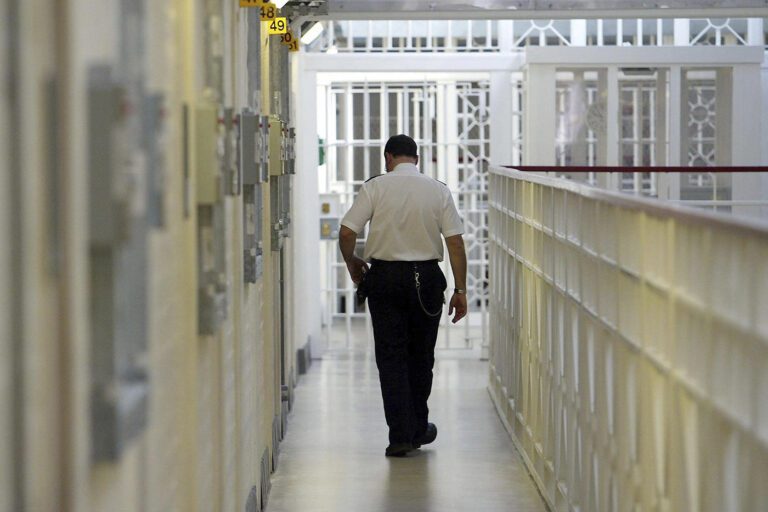In the decade leading up to 2020, the racial disparity in incarceration in the US was on the decline – until the COVID-19 pandemic hit.
In the early days of the pandemic, COVID-19 hit prison populations hard, prompting federal and state leaders to release of tens of thousands of prisoners. But new data by a team of researchers led by experts from Northeastern University, Yale University and the Santa Fe Institute reveals that mass liberation did not apply equally to people of color. The data, collected and released for the first time, reveals a series of long-standing, persistent inequalities in the criminal justice system and how the pandemic was just the spark that lit the fuse.
“We were able to estimate that 15,000 people should have come out of jails and prisons if you didn't have racial disparity during that three- or four-month period in early 2020,” he says. Samuel Scarpino, director of AI and life sciences at Northeastern's Institute for Experiential AI. “What we uncovered were the persistent, long-term effects of disparity in sentencing that targets black people and also targets, but to a lesser extent, non-white, non-black people.”
For Scarpinos and Brennan Klein, a postdoctoral researcher at the Network Science Institute, the project began as a follow-up to their data-driven work examining disparities in the outcomes of COVID-19. When they started looking for captive populations, they ran into a problem. It is incredibly difficult to access data on the number of people incarcerated in a given state prison system, and when they did access it, the data was messy or out of date.
In trying to find the missing data, Scarpino and Klein stumbled upon something much bigger.
Over the course of 18 months, Klein filed countless Freedom of Information Act requests and dug into numerous agency websites to find the data they were looking for. What he ended up with was years worth of monthly data on each state's prison population, broken down by race and ethnicity.
“This is the first time a data set like this has ever been collected and will ever be released publicly,” says Scarpino.
What immediately jumped off the page was that in the 10 years leading up to 2020, the relative percentage of non-white prisoners was slowly but steadily declining, coinciding with a general decline in the prison population. In 2013, 41.6% of incarcerated people in the US were black. at the beginning of the pandemic, it had fallen to 38.9%.
The second thing the researchers noticed was what happened in 2020.
“Go into the pandemic, and during the first part of 2020, we had the largest reduction in people incarcerated in human history,” Scarpino says. “What ended up happening was that the ratio was not white [people] rose, reversing a decade of declining racial inequality.”
The mass release of people from US jails and prisons that occurred in the first year of the pandemic reduced the overall prison population by 17%, according to Scarpino and Klein. Meanwhile, the non-white incarcerated rate rose 0.9 percent, effectively erasing most of the progress made over the past decade. Although it was only a modest 0.9% increase, Klein says that even a small percentage change can make a difference in the lives of thousands of people.
“Because we incarcerate so many people in this country, the rates that don't necessarily seem like a huge swing on the surface … once you do the math with those numbers, you end up with a lot of lives that are really seriously affected by this disparity,” he says. Klein.
Klein says that if the decline in the overall white population that occurred during the pandemic was applied to the incarcerated black population, there would be 15,000 fewer black people in prison across the US
When it comes to the criminal justice system in the U.S., “everything is disproportionate in terms of race and ethnicity,” says Scarpino. But what surprised the researchers was the “key mechanism” that explained how this happened: condemnation.
“People stop being admitted to jails and prisons because the courts were closed, so nobody's getting in,” Scarpino says. “A bunch of people are being released through parole because of COVID and also being released just because their terms are up. The people who were left behind are the ones who ended up with sentences that were longer than they 'should' have been, and those people were disproportionately black.”
According to Scarpino and Klein, there is an active debate among criminal justice experts about what the biggest drivers of inequality are. With this data, they are able to identify a specific factor that, if addressed, could improve the system as a whole.
In a criminal justice system where proving bias or discrimination at the person-to-person level is difficult, that could make a difference, Scarpino says. Moving forward, Scarpino and Klein will work with Harvard University's Institute on Policing, Incarceration, and Public Safety to create a data and legal services clinic that will “start to identify the most compelling cases to apply our methods to.” and then getting people in front of judges and in courtrooms to start changing those laws,” says Klein. It's just the beginning of what researchers see as the role data can play in helping to effect social change.
“One of the things we hope to do with this paper is to create a whole new field where the legal system in the US can redress racial injustice through big data,” says Scarpino. “We can recognize the fact that the whole system is inequitable in terms of even basic things like how long you're sentenced for the same crime, and then redress that through the legal system.”
Cody Mello-Klein is a reporter for Northeastern Global News. Email him at c.mello-klein@northeastern.edu. Follow him on Twitter @Proelectioneer.



